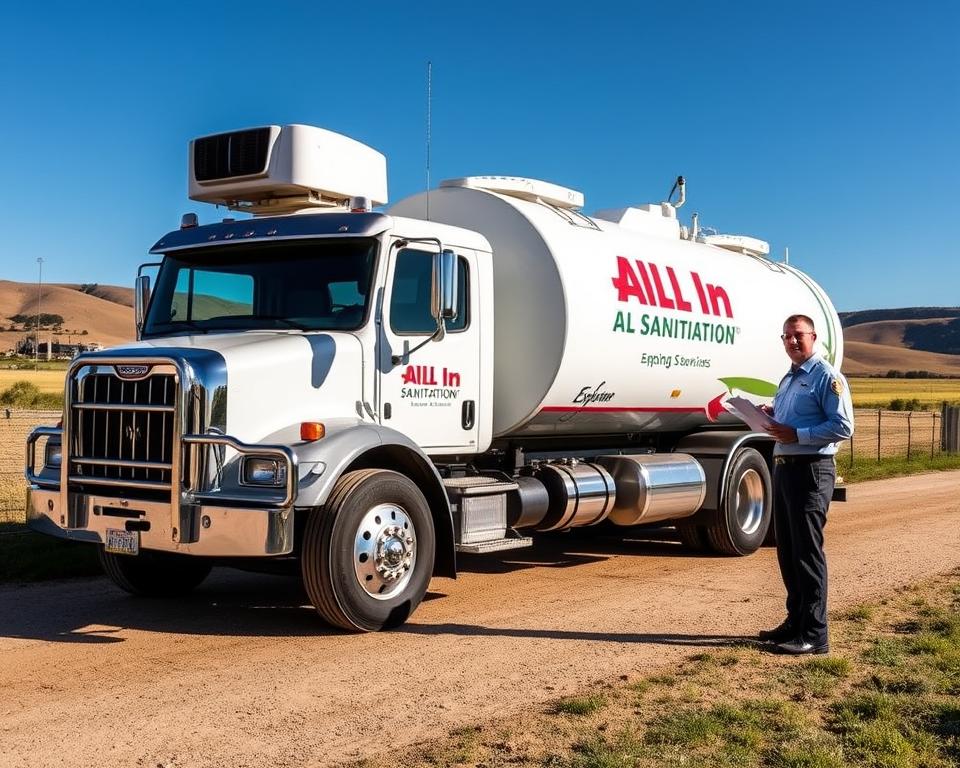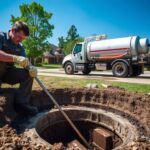Understanding and Maintaining Your RV Black Water Tank Pump
The functionality of your RV black water tank pump is crucial for your travels, have you ever wondered about it? It’s a key element of your RV’s sanitation system. Proper maintenance is crucial for seamless travels. This guide will give you the important information you need to manage your RV waste water pump. If you understand its importance, you can improve its performance and have even better RV experiences.
Main Insights
- The RV black water tank pump plays a vital role in efficient waste disposal.
- Regular maintenance can prolong the lifespan of your RV waste water pump.
- Understanding system components enhances troubleshooting skills.
- Practicing safe dumping is important for both your health and the planet.
- You can avoid expensive repairs by winterizing your RV black water tank system.
- A clean RV sanitation pump helps prevent blockages and bad smells.
The Importance of Understanding RV Water Tanks
It’s conceivable that numerous RV owners don’t entirely appreciate the role of different water tanks in ensuring smooth camping experiences using RV pressure tank. It’s essential to know what the RV fresh water, gray water, and black water tanks do. Each plays a unique role and needs proper care.
The RV fresh water tank is for storing drinkable water. You use it for drinking, preparing food, and personal cleanliness. The cleanliness of this tank and the safety of the water are extremely important. Fresh water is crucial for hydration and health during travels.
On the other hand, the RV gray water tank collects wastewater from sinks and showers. It’s possible for this tank to fill up fast, so you need to check it often and empty it. Proper gray water tank management is essential for a clean RV living space.
Holding waste from the toilet, the RV black water tank is very important. It demands constant vigilance to avoid smells and buildup. Applying the proper tank chemicals will improve the tank’s condition and your RVing experience. Knowing how to care for each tank makes RV trips more enjoyable.
RV Black Water Tank Pump: An Explanation
This RV black water tank pump plays a crucial role in the sanitation of recreational vehicles. The pump’s function is to move waste to the appropriate disposal areas. Understanding its operation is crucial for proper maintenance and preventing costly repairs.
RV owners can choose from various pump types, including the sewer pump. A popular option is the macerator pump, as it grinds waste, resulting in quicker disposal. This is particularly useful when dump stations are crowded.
A quality RV black tank pump is crucial for waste management. This pump contributes to a clean and comfortable environment inside the RV. You can improve your RV experience by regularly checking your pump and understanding how it operates.
Identifying the Components of the Black Water Tank System
A key to managing waste efficiently is understanding the RV black water tank system. It involves numerous vital components that work together to ensure smooth functionality. Waste from the RV toilet is stored in the black water tank, the system’s most critical component. It’s made with durable materials so that it can handle various conditions.

The pump in the system is crucial for moving waste to an official dump site. It’s a must-have for anyone with an RV. Sewer hoses are also crucial, as they provide a flexible connection from the tank to the dump station. By preventing leaks and containing odors, these hoses ensure a clean waste disposal process.
To attach sewer hoses and allow for efficient waste transfer, connection ports are necessary. Controlling the flow of waste is the crucial role of termination valves. During disposal, they stop waste from flowing backward and prevent spills, thus maintaining sanitation.
For RV owners to maintain their sanitation system efficiently, they need to be familiar with these essential components. This understanding is vital for solving problems during trips or when using the RV, enhancing the entire RV experience.
Using Your RV Black Water Tank Pump Correctly
Knowing how to use the RV sanitation pump well greatly makes better your experience as an RV owner. For a system that runs smoothly, it’s essential to know how to use the black tank correctly. It’s very important to flush the tank completely after every time you use it. This practice helps avoid the buildup of solid waste, which might result in blockages and other issues.
Checking your RV sanitation pump regularly makes sure it’s working the way it should. This helps you avoid any bad situations when you’re traveling. It is also essential to use toilet paper made specifically for RVs. This type of paper is designed to dissolve rapidly, thus reducing the likelihood of clogs.
Another key practice is to keep the termination valves closed, unless you are emptying the tank. It helps to stop odors from spreading. Tank deodorants and cleaners can also be added to help maintain a pleasant smell and cleanliness in the system. Adhering to these guidelines improves your experience with the RV black water tank.
| Guidelines for Using Your Black Tank Correctly | Pros |
|---|---|
| Make Sure to Flush with Enough Water | Prevents solid waste clogs |
| Check the Pump Operation Regularly | Ensures it functions effectively |
| It’s Important to Use RV-Specific Toilet Paper | Lowers the chance of clogs |
| Ensure the Termination Valves Remain Closed | Lowers the amount of odor |
| Add Tank Deodorants and Cleaning Agents | Keeps the system odor-free and hygienic |
Essential Maintenance Tips for the Black Water Tank Pump
Regular maintenance is essential to make sure your RV’s black water tank pump lasts and works well. One aspect of this is using the correct chemical treatments that are intended for these tanks. These chemicals effectively break down waste and keep odors away.
Another crucial thing is to ensure sufficient water flow when using the toilet. This helps the waste travel easily to the tank, which reduces the chance of buildup. Don’t forget to also regularly perform a deep clean of the tank and its components. It’s important to use the tools that are recommended for this job.
Keep an eye on the tank levels at all times to prevent problems. Make sure to address any leaks or overflows as soon as you see them. Regularly emptying the tank is important to prevent the accumulation of solid waste. Creating a maintenance schedule helps ensure a trouble-free RV experience.
| Job for Maintenance | Regularity | What to Do |
|---|---|---|
| Look at levels | Each time you travel | Check that the tank isn’t filled beyond capacity to prevent leaks. |
| Use chemicals | Following each emptying | Add treatments to break down waste effectively. |
| Do a system flush | Once a month | Use a cleaning solution to maintain tank cleanliness. |
| Inspect the pump | Before long trips | Inspect for any wear or damage so you don’t have breakdowns during your trip. |
| Tank emptying | When it’s full | It’s best to empty the tank at designated dump stations when it reaches full capacity. |
Following these key maintenance practices will ensure your black water tank pump works well. This will improve your RV trips significantly.
Dealing with Common Black Water Tank Pump Issues
It can feel overwhelming to troubleshoot issues with the black tank pump. Many RV owners encounter various RV black tank problems such as clogs, leaks, or persistent odors. Addressing these issues early can help you save time and avoid expensive repairs later.
Begin by examining the hoses that are linked to the black tank pump. These areas are where blockages frequently happen, which causes the pump to not work well. Remove the hoses and inspect them for any blockages or debris. If you discover any blockages, ensure the hoses are completely clean before you put them back.
After that, check the seals that are around the pump and the tank. If the seals are damaged, it can cause leaks that you might not notice until a lot of damage has been done. Replace any faulty seals immediately to prevent further issues.
If you’re dealing with odors that just won’t disappear, enzyme treatments might be useful. These treatments help break down waste and reduce offending smells. To get the best results, be sure to follow the instructions that came with the product.
This is a table that quickly shows common problems and how to fix them:
| Issue | Reason It Could Be Happening | Remedy |
|---|---|---|
| Jams | Debris in hoses or tank | Make sure to check and clean the hoses |
| Loss of liquid | Faulty seals | Make sure to inspect the seals and replace any that are damaged |
| Bad smells | Waste buildup | Treat with enzymes |
| Pump not working | Issues with the wiring | Check connections and battery |
Spotting the initial signs of trouble can prevent minor issues from escalating into serious RV black tank problems. Regular maintenance and vigilance will enhance the longevity of your black tank pump, enhancing your RV experience.
RV Black Water Tank Pump Cleaning Techniques
Maintaining a clean RV black water tank is crucial for both hygiene and the proper operation of its plumbing system. Aim to minimize odors and ensure everything functions smoothly by rinsing with fresh water after use. By doing this, you reduce the accumulation of waste and help maintain the tank’s condition.
If you want to clean it more thoroughly, use cleaning products that are specifically designed for black water systems. They are effective in dissolving waste and combating odors. Fill the tank with water and cleaning solution, then let it soak. If your RV has a flush system that’s built in, it will make cleaning easier.
Driving with sharp turns or using sloshing techniques can help to stir up the contents of the tank. It helps to dislodge any residue that might be on the walls of the tank. Cleaning in this way helps the sensors be more accurate, which can help you avoid sewage problems.
Best Practices for Safe RV Waste Dumping
Knowing the proper way to behave at RV dump stations is important so that everyone can use them comfortably. Upon reaching a station, make sure your RV is positioned correctly. Then, get your gear ready for dumping.
For a smooth process, make sure to follow these steps closely:
- Make sure your sewer hose is firmly connected to the station’s outlet.
- The first step is to open the black water valve so the sewage can flow out.
- Close the valve of the black tank after it’s empty. Then, open the gray water valve to clean the hose with the less dirty water.
- Once the process is complete, carefully detach your hose to prevent any spillage.
- Be sure to always clean your hoses with water that’s safe to drink and then put them away immediately.
Following the local laws about how to dispose of waste is also very important. A lot of areas have rules that you need to follow to help protect the environment. If you don’t follow these rules, you could get fines or other penalties.
It’s important to be respectful at RV dump stations so that everyone has a better experience. By maintaining a clean area and adhering to the rules, you demonstrate care for the community. Such actions foster a culture of responsibility among RV enthusiasts and encourage eco-friendly camping habits.
Winterizing Your RV Black Water Tank System
To ensure your black water system doesn’t freeze, winterizing your RV tanks is essential. It’s crucial to prepare your system properly to avoid damage from water that freezes inside. By following certain steps, you can ensure that your RV black tank is properly cared for during the winter.
- Begin by completely emptying the black water tank using the correct pump and connections.
- Then, you should bypass the water heater to prevent water from entering and accumulating inside.
- Be sure to use RV antifreeze, because regular antifreeze can be toxic and can harm the environment. Pour the antifreeze into the system according to the product instructions.
- Leave all faucets and drains open to allow any remaining water to escape and for the antifreeze to circulate properly.
- Finally, ensure that all access panels are properly sealed and secured to prevent water from entering during the winter.
These winterization steps help RV owners protect their black water tank systems from the damaging effects of winter. Thinking ahead like this helps to prevent costly repairs or maintenance when the weather changes.
Wrapping It Up
Successful RV ownership relies heavily on efficient maintenance of the RV black water tank. By becoming proficient with the black water tank pump and following the maintenance strategies in this guide, your travel experiences will be more enjoyable. By taking good care of your equipment, you’ll extend its life and simplify the process of managing waste in your RV. This makes travel less daunting.
To handle problems with your RV’s black water system effectively, you need to know about it. Following good maintenance, troubleshooting, and cleaning procedures will help prevent unexpected malfunctions. This lets you enjoy worry-free road trips. Working with reputable services like All in Sanitation can bolster your maintenance efforts. They provide the key products and support needed for excellent maintenance.
Being a good RV owner means paying attention to and taking proper care of every part of your RV, including the black water tank. Having this information means you’re now ready to explore without any concerns. You’ve taken all the right steps to make sure you and others have an excellent journey.

